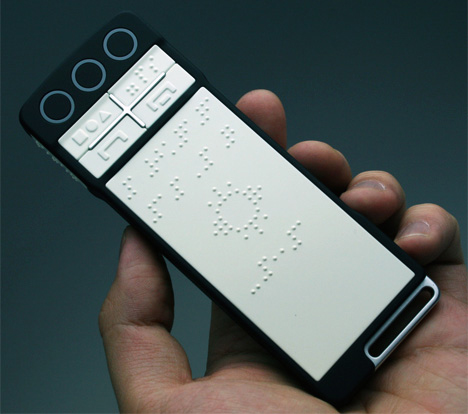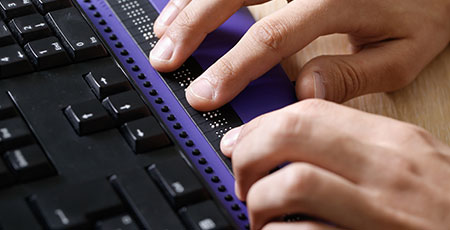Braille Displays and Notetakers: Key Tools for Learning and Work
Wiki Article
Enhancing Lives With Advanced Assistive Instruments for the Blind
The combination of sophisticated assistive gadgets for the blind is transforming exactly how people experience their surroundings and interact with their communities. What does this evolution indicate for the future of assistive technology and its duty in encouraging individuals?Introduction of Assistive Tools
Assistive devices for the blind encompass a varied variety of devices and technologies made to enhance freedom and improve the high quality of life for people with aesthetic problems. These gadgets accommodate different requirements, from navigation and flexibility to interaction and day-to-day task monitoring.One of the main classifications of assistive devices includes mobility help, such as white walking sticks and guide pet dogs, which aid individuals navigate their environments securely. Digital traveling help, furnished with sensors and audio feedback, additionally play a significant duty in mobility improvement.
In addition, devices that assist with everyday living activities, such as flexible kitchen area devices, Braille labels, and speaking watches, encourage people to carry out tasks individually. Communication aids, consisting of display viewers and Braille displays, assist in accessibility to details and enable people to engage effectively with the electronic world.
Moreover, low-tech options like amplifying glasses and large-print products stay important for lots of users. Jointly, these assistive devices offer not only as functional tools yet also as essential enablers of autonomy, cultivating greater engagement in a world that often focuses on sighted experiences. Their integration right into day-to-day live is crucial for advertising inclusivity and improving total wellness for those with visual disabilities.
Innovative Technologies in Use
Advancement in innovation has actually substantially changed the landscape of tools offered for people with visual disabilities. Amongst one of the most noteworthy innovations are smart glasses integrated with increased fact, which offer real-time navigating aid and object recognition. These tools leverage advanced cams and fabricated knowledge to supply auditory hints, enhancing the customer's spatial recognition and autonomy.Furthermore, mobile applications have actually arised as effective sources, enabling users to determine currency, checked out message out loud, and browse strange settings through verbal directions. Tools such as Braille screens and refreshable Braille tools proceed to advance, offering seamless connection with computer systems and smart devices, consequently boosting interaction and accessibility to details.
Wearable modern technology, consisting of smartwatches outfitted with voice-activated attributes, additionally equips individuals by assisting in quick access to notifications and alerts without requiring aesthetic involvement. Responsive maps and 3D printing are likewise acquiring grip, supplying substantial depictions of areas that aid in orientation and flexibility training.
Jointly, these ingenious innovations not only improve the every day lives of aesthetically impaired individuals but also foster better self-reliance, inclusivity, and engagement with the more comprehensive neighborhood, thus reshaping assumptions of availability. (Assistive technology for the blind)
Individual Stories of Empowerment
Empowerment typically emerges from individual experiences that highlight the transformative impact of modern technology on individuals with aesthetic disabilities. Take, for example, the tale of Sarah, a young artist that reclaimed her passion for paint via making use of a wise cane outfitted with challenge discovery. This device not just promoted her movement yet instilled a newfound confidence, permitting her to navigate public rooms independently and seek why not try these out her imaginative ventures.
These narratives emphasize the profound results that advanced assistive devices can carry daily life. By making it possible for individuals to overcome obstacles, innovation fosters a feeling of freedom and self-regard. Such empowerment stories act as a testimony to the possibility of technology, showing just how the right tools can dramatically improve lifestyle and open doors to new opportunities for those with aesthetic impairments.
Benefits of Advanced Solutions
Just how can advanced services essentially improve the lives of people with aesthetic problems? The assimilation of advanced innovation right into go to this web-site assistive devices dramatically transforms daily experiences for those impacted by vision loss. These sophisticated services offer unprecedented autonomy, enabling customers to browse their settings with self-confidence. Tools such as wise walking sticks outfitted with sensing units, navigation apps, and wearable modern technology are designed to offer real-time comments, enhancing spatial awareness and minimizing the threats associated with mobility.
Furthermore, advanced assistive technologies promote social inclusion by helping with interaction and interaction. Voice-activated devices and apps permit individuals to accessibility information and involve with their environments separately, damaging obstacles that previously prevented their involvement in instructional, specialist, and social settings.
Additionally, the modification and adaptability of these solutions satisfy the varied demands of customers, therefore improving their total high quality of life. Improved performance, such as things acknowledgment and text-to-speech capacities, empowers people with aesthetic impairments to carry out jobs that they might have once discovered testing. Ultimately, advanced assistive innovations not just enhance independence and security yet additionally advertise self-respect and self-regard, allowing users to lead fulfilling lives.
Future Trends in Assistive Tech
As modern technology continues to evolve, the landscape of assistive devices for the blind is poised for impressive advancements that will even more boost ease of access and independence. Arising fads in assistive modern technology suggest a shift towards boosted integration of expert system (AI) and artificial intelligence, allowing tools to adjust to private customer needs in real-time. These developments are anticipated to help with more intuitive navigation systems that can identify obstacles and supply audio comments, have a peek here substantially enhancing exterior mobility.Additionally, the advancement of wearable tech, such as clever glasses equipped with enhanced reality, will certainly enable users to get contextual info about their environments, consequently improving their spatial understanding. Advancements in haptic modern technology assurance to produce responsive feedback tools, permitting users to view info through touch, improving knowing and interaction with their atmosphere.
Telecommunication breakthroughs are likewise leading the way for remote support services, where experienced specialists can provide support using video phone calls, making sure support is easily available. As these patterns unravel, the future of assistive devices for the blind will most certainly foster higher autonomy, empowering people to browse their globe with self-confidence and convenience.

Conclusion
The integration of sophisticated assistive devices for the blind stands for a substantial advancement in promoting independence and improving lifestyle. By utilizing cutting-edge technologies, these gadgets empower users to navigate their atmospheres with better confidence and autonomy. As the area remains to evolve, ongoing research study and growth will likely generate also extra sophisticated solutions, further changing the lived experiences of people with visual impairments and advertising a better feeling of inclusion within society.
The integration of innovative assistive devices for the blind is changing exactly how people experience their environments and engage with their communities. The integration of innovative innovation right into assistive tools considerably transforms everyday experiences for those impacted by vision loss.As modern technology continues to advance, the landscape of assistive tools for the blind is poised for exceptional innovations that will certainly better improve ease of access and independence. Arising patterns in assistive innovation show a change towards boosted combination of fabricated knowledge (AI) and maker discovering, allowing gadgets to adjust to individual user needs in real-time.The assimilation of innovative assistive gadgets for the blind stands for a substantial improvement in fostering freedom and boosting high quality of life.
Report this wiki page